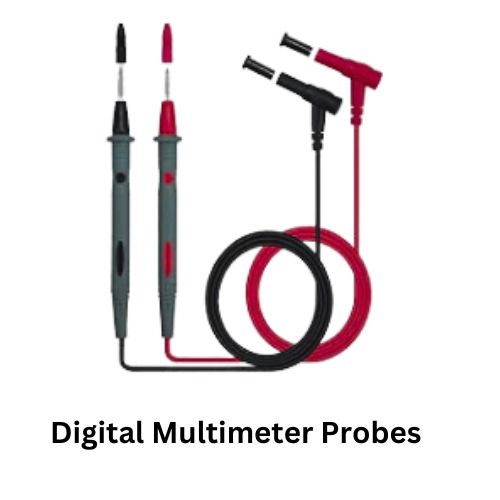Digital Multimeter (DMM) Probes are essential accessories used to connect the multimeter to the circuit or component being tested. They allow the user to measure electrical values such as voltage, current, resistance, and continuity.
Description of Digital Multimeter Probes:
1. Structure:
-
Probe Tips:
-
Sharp metallic ends for making contact with the test point.
-
Typically gold- or nickel-plated to ensure conductivity and reduce corrosion.
-
Comes in different forms (needle, hook, clip, etc.) depending on the use case.
-
-
Probe Handles:
-
Insulated plastic body for safety and easy handling.
-
Often color-coded: Red for the positive terminal, Black for the common/ground terminal.
-
-
Leads/Wires:
-
Flexible, insulated wires connecting the probe to the multimeter.
-
Designed to be durable and tangle-resistant.
-
Usually silicone-insulated for flexibility and heat resistance.
-
-
Banana Plugs/Connectors:
-
Ends of the leads that plug into the multimeter.
-
Standard 4mm banana plugs, sometimes shrouded for extra safety.
-
2. Types of Probes:
-
Standard Test Probes: Most common type with sharp tips.
-
Alligator Clips: For hands-free operation; clip onto wires/components.
-
Hook Probes: Hook onto small components like IC legs or wires.
-
Temperature Probes: For measuring temperature (thermocouples).
-
High-Voltage Probes: For measuring high voltages safely.
3. Safety Features:
-
CAT Ratings (e.g., CAT II, CAT III, CAT IV): Define the maximum voltage and environment the probe can safely be used in.
-
Insulated Tips: Minimize accidental shorts.
-
Finger Guards: Prevent fingers from slipping toward the tip.
4. Usage Tips:
-
Always inspect probes for damage before use.
-
Match the probe rating to your measurement environment.
-
Use proper probe type for accurate and safe readings.


Reviews
Clear filtersThere are no reviews yet.